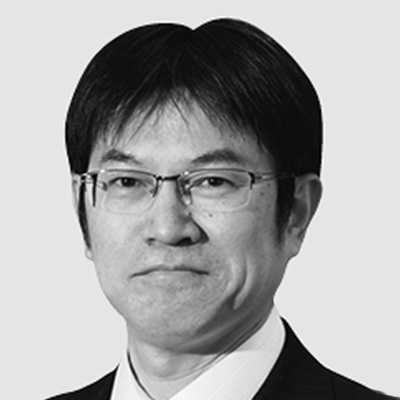Research and development needs to be an early adopter of new trends such as data capitalism that are creating major worldwide structural changes in industry along with the rise of digitalization. Up to now, Hitachi’s research and development approach has consisted of releasing priority products through project-based work, while making strategic improvements to technology platforms. The company plans to supplement these activities by creating world-class technologies originating from the new value being found in today’s growth areas. It will also work on augmenting the functions of its Lumada platform to rapidly provide solutions in five focus areas—mobility, smart life, industry, energy, and IT. Another activity will be augmenting its work on worldwide open innovation by assisting cutting-edge technology development in hot spots and contributing Social Innovation Business in the overseas regions.

General Manager of Center for Technology Innovation, Research & Development Group, Hitachi, Ltd. Society memberships: The Society of Instrument and Control Engineers (SICE) and the Institute of Electrical Engineers of Japan (IEEJ).

Deputy General Manager of Center for Technology Innovation, Research & Development Group, Hitachi, Ltd. Society memberships: IEEJ.

Deputy General Manager of Center for Technology Innovation, Research & Development Group, Hitachi, Ltd. Society memberships: IEEJ, IEEE, and International Council on Large Electric Systems (CIGRE).
The scope of Hitachi's research and development (R&D) work has grown over the years in response to structural changes in industry. Founded in 1910, the company focused on R&D of products and operational technology (OT) such as motors, generators, and rolling stock after the creation of a research department in 1918. With the emergence of the IT sector in the 1960s, Hitachi responded by shifting the focus of its R&D work more toward information devices such as computers, servers, and storage devices. Since 2015, its R&D work has been experiencing another major transformation as further advances in digitalization have resulted in the worldwide popularity of work on Internet of Things (IoT) applications that combine OT and IT. Along with this transformation, the company also expanding the scope of its R&D by moving away from the traditional core of R&D for technological challenges, toward R&D for customer challenges and societal challenges. Figure 1 illustrates this trend.
In the years ahead, Hitachi will need to respond to the major worldwide structural changes taking place in industry by pioneering new Social Innovation Business areas based on social value, environmental value, and economic value. Crucial for achieving these goals will be expanding areas of application while bundling the various technologies it has accumulated and refined over its past century of R&D.
This article presents the work being done by Hitachi's Research & Development Group, examining the latest development technologies that bundle Hitachi's OT, IT, and product expertise. Also described is the Group's work on open innovation that is accelerating the construction, research, and development of platforms that rapidly provide solutions to customers.
Figure 1—Hitachi’s Research and Development Work Since its first research and development department was created, Hitachi has been expanding the scope of its R&D work to meet the demands of the changing times. It will continue to step up its R&D efforts in the years ahead.
Since its first research and development department was created, Hitachi has been expanding the scope of its R&D work to meet the demands of the changing times. It will continue to step up its R&D efforts in the years ahead.
Creating and focusing on world-class technologies are vital requirements for attaining Hitachi's goal of becoming a global leader. Hitachi's development history contains a number of world-class technologies, products, and systems. Examples include high-speed, low-noise rolling stock, the world's fastest elevator, a proton beam therapy system for cancer treatment helping improve patient quality of life (QoL), semiconductor inspection systems and biochemical-immunological systems with dominant global market shares, industrial equipment such as air compressors and motors, energy systems, and storage systems. In addition to these technologies, future R&D work will focus on five areas—mobility, smart life, industry, energy, and IT. Listed below are the Hitachi's latest research achievements made in these areas by drawing on it's OT, IT, and product strengths.
Hitachi excels at analysis-led design and combination optimization technologies, which it draws on to provide a comprehensive lineup of railway solutions encompassing everything from rolling stock and accessory devices, to signals/systems, service/maintenance, and turnkey infrastructure. It has also proposed a system called a Dynamic Headway solution that was demonstrated by Copenhagen Metro. Designed to provide new value by eliminating congestion, the solution uses sensors installed in stations to analyze passenger numbers and automatically optimize the number of trains operated in response to passenger increases and decreases.
To provide new value tailored to today's changing and diversifying lifestyles, Hitachi is working on refining conventional consumer electronics into a new category of ‘connected appliances.' In FY2017, it released a robot cleaner that enables smartphone-based operations and reservations, and provides handy operation using automatic dust-collection technology customized to the floor type and dirt quantity. In FY2018, Hitachi released a front loading washer/dryer with functions that let the user know when laundry has finished or is about to finish, and when the filter and drum need maintenance.
To provide new value in the form of patient QoL improvement combined with reduced healthcare costs, Hitachi is working on developing early diagnostic technologies that combine high-precision biomeasurement technology with image analysis technology. For example, it was the first company in the world to incorporate quantitative susceptibility mapping (QSM) technology into magnetic resonance imaging (MRI) products. QSM technology measures the magnetic susceptibility of living tissue to enable quantitative analysis of iron or nerve fiber quantities. Combining QSM technology with voxel-based morphometry (VBM) technology that analyzes brain atrophy is expected to enable highly accurate diagnosis of Alzheimer's and help prevent its advance*1.
Hitachi has developed technology that automatically controls sites by combining artificial intelligence (AI) with site expertise obtained from IoT data about site equipment, personnel, objects, and work methods. The technology provides analysis, predictions, and suggested solutions spanning the entire value chain. These new types of value are being offered in the form of solutions on the Lumada platform to customers inside and outside the Hitachi.
For example, Hitachi's solutions for plants work with compressors and software-defined programmable logic controllers (PLCs) to monitor parts deterioration, to diagnose failure precursors, and to present maintenance plans with low impact on production. Its solutions for warehouses work with Racrew and other materials handling robots to issue picking instructions designed to improve overall warehouse work efficiency. To create logistics solutions, the company developed technology that uses telematics to identify truck and driver conditions. It suggests delivery plans in real time while accounting for delivery port usage conditions, busy times, peak time, traffic congestion, and similar conditions. The solutions offered reduce delivery delay at times of truck or driver shortages.
Countries around the world are eagerly anticipating the use of battery-powered rail transport, electric vehicles (EVs), and renewable energy as a way to help create low-carbon economies (a new value area). Reducing drive-system size to create enough room to mount the batteries needed to extend EV range is one of the roadblocks to EV popularization. In 2013, Hitachi started mass production of a direct double-sided cooling power module that is the first of its kind in the world. It has successfully managed to reduce the size of drive inverters for EVs and plug-in hybrid vehicles (PHVs) sold in the USA and European markets. Its output power density of 57.4 kVA/L is the world's highest for a mass-produced power module (as researched by Hitachi in May 2019). The company is also working on expanding its environmentally friendly system services segment. It includes battery management services that promote the use of renewable energy sources such as wind power and solar power by making effective use of fixed batteries and EVs spread throughout street or facility parking lots.
While conventional insurance is ‘reactive' in that it handles accidents or other incidents after-the-fact, Hitachi is working with insurance companies to create a new type of ‘proactive' insurance that starts providing service before an incident occurs. The preventive maintenance services offered to manufacturers such as chemical plants are made possible by a wide range of IoT sensing technologies and high-precision precursor diagnostic technologies. By combining them with insurance(8), Hitachi should be able to generate new value by ensuring stable operation and improving productivity throughout entire manufacturing sites.
As presented in the articles that follow, Hitachi is also working on several other areas besides the work above. These areas include work on energy systems, advanced analysis-led design for mobility applications, improving diagnostic accuracy with AI, improving robot control efficiency with an autonomous and collaborative robotics technology, and Lumada platform services.
The company is also working on technology development for the software-defined(9) movement, a new trend it has identified that puts more weight on product functions by shifting the focus from hardware to software. For example, technology to continually update software over a network is attracting interest as users are increasingly placing value on keeping software functions continually up-to-date or optimized.
Hitachi's work in the automotive segment includes development of a technology for over-the-air (OTA) updating of control software using wireless communication. For automotive systems with limited network bandwidth or memory resources, it is working on developing incremental updating technology that reduces updating time, and secure transmission technology that provides a multilayer defense of update data sent from the center to the vehicle. These technologies will be beneficial in the evolution toward the coming era of autonomous driving.
To optimize infrastructural systems, Hitachi's Social Innovation Business is going to need increasingly efficient ways of processing combination optimization problems. Hitachi is now working on developing a complementary metal-oxide-semiconductor (CMOS) annealing machine(10) that enables a scalable configuration matching the scale of an optimization problem by supporting connection of multiple semiconductor chips. Previously, the company created one of the largest annealing machines in the world (100 kbit) by connecting 25 semiconductor chips of a type known as field-programmable gate array (FPGA). This product has been released as a cloud service, stepping up the pace of collaborative creation of solutions with partners.
Hitachi's Lumada(11) platform is the collective term for solutions, services, and technologies that use digital technologies. The recent rise of digitalization is creating increasingly rapid change in the business environment, so the platforms used as the cornerstone of solutions provided to customers need to be flexible and rapid enough to handle this change.
Lumada uses the system-of-systems approach of connecting multiple systems into a larger system and creating new value. It uses this approach to ensure interconnectability, ensure quality, and increase development efficiency. All these benefits are provided in the form of platform functions.
To increase development efficiency, Hitachi has used open source software (OSS) such as Node-RED*2, Kubernetes*3, Docker*4, and Istio*5 to create functions for storing previously developed applications in executable format and reusing them to develop new applications. These functions have been released as Lumada Solution Hub. The Research & Development Group is working to incorporate a series of developed technologies into Lumada, enabling new value to be provided rapidly from OT, IT, and products.
Much of the work above is being done to address customer challenges and societal challenges. Hitachi is working on stepping up the pace of R&D by promoting open innovation with partners outside the company throughout the world.
For example, it is working with the University of Utah to develop AI technologies that help doctors choose the best drug to treat each patient. It should be possible to create better healthcare services by having doctors and patients decide on treatment approaches through discussion(12). Hitachi is also working with the German Research Centre for Artificial Intelligence to develop AI that recognizes the type of work being done by wearers of wearable devices. The findings of this project could be used to assist work operations and prevent human error, so it should help improve quality and efficiency at production sites. The company plans to work on AI-driven technology development in a number of different areas.
To promote autonomous driving, Hitachi is working on a joint research project with the Fraunhofer Society, a German research organization highly accomplished in this area. Seeking to help promote an era of safe autonomous driving, it is working collaboratively on creating and standardizing methodologies for safety technologies.
Hitachi also actively takes part in collaborative creation activities with public-private sector initiatives as a way to work toward solutions to societal challenges by promoting joint public-private sector agreements. Created by the World Economic Forum (WEF), the Centre for the Fourth Industrial Revolution (C4IR) is an organization that creates advance drafts of international policies representing the public's consensus in areas such as AI, blockchain, data distribution, and autonomous driving technologies. Hitachi began sending fellows to C4IR's San Francisco lab in April 2018, working with the organization to create policies for the areas mentioned. It also took part in C4IR Japan activities in FY2019, expanding the scope of collaborative creation.
The company plans to take part in a project with Germany's National Academy of Science and Engineering (acatech), the original proponent of the Industrie 4.0 concept. The project will involve collaboration between industry and academia in Germany and Japan, with discussion of visions and problem-solving policies related to new relationships between machines and diverse groups of people in the digital era. A white paper of the findings will be published.
This article has discussed the research and development work Hitachi is doing to promote the worldwide growth of its Social Innovation Business. The company is working with partners around the world to step up the pace of these efforts and develop technologies designed to address societal challenges and improve QoL.